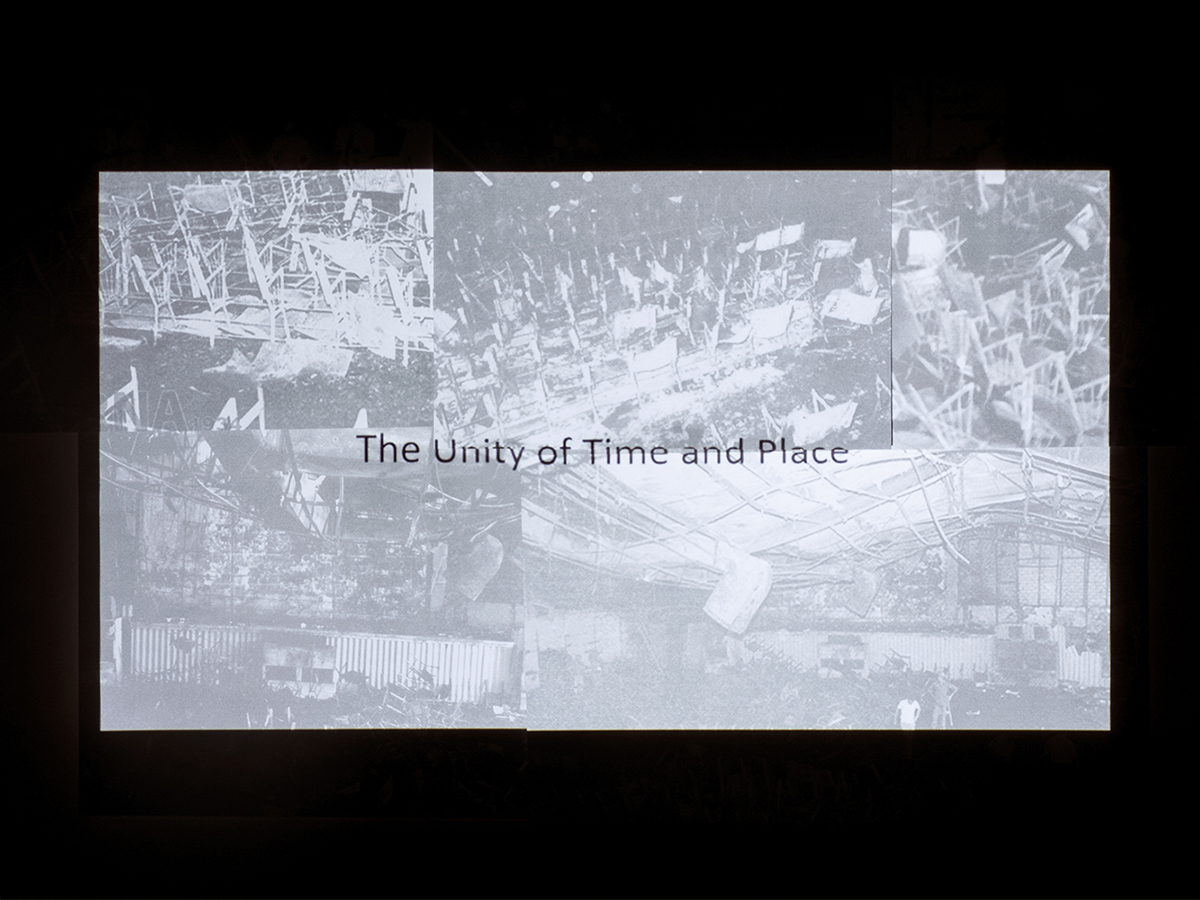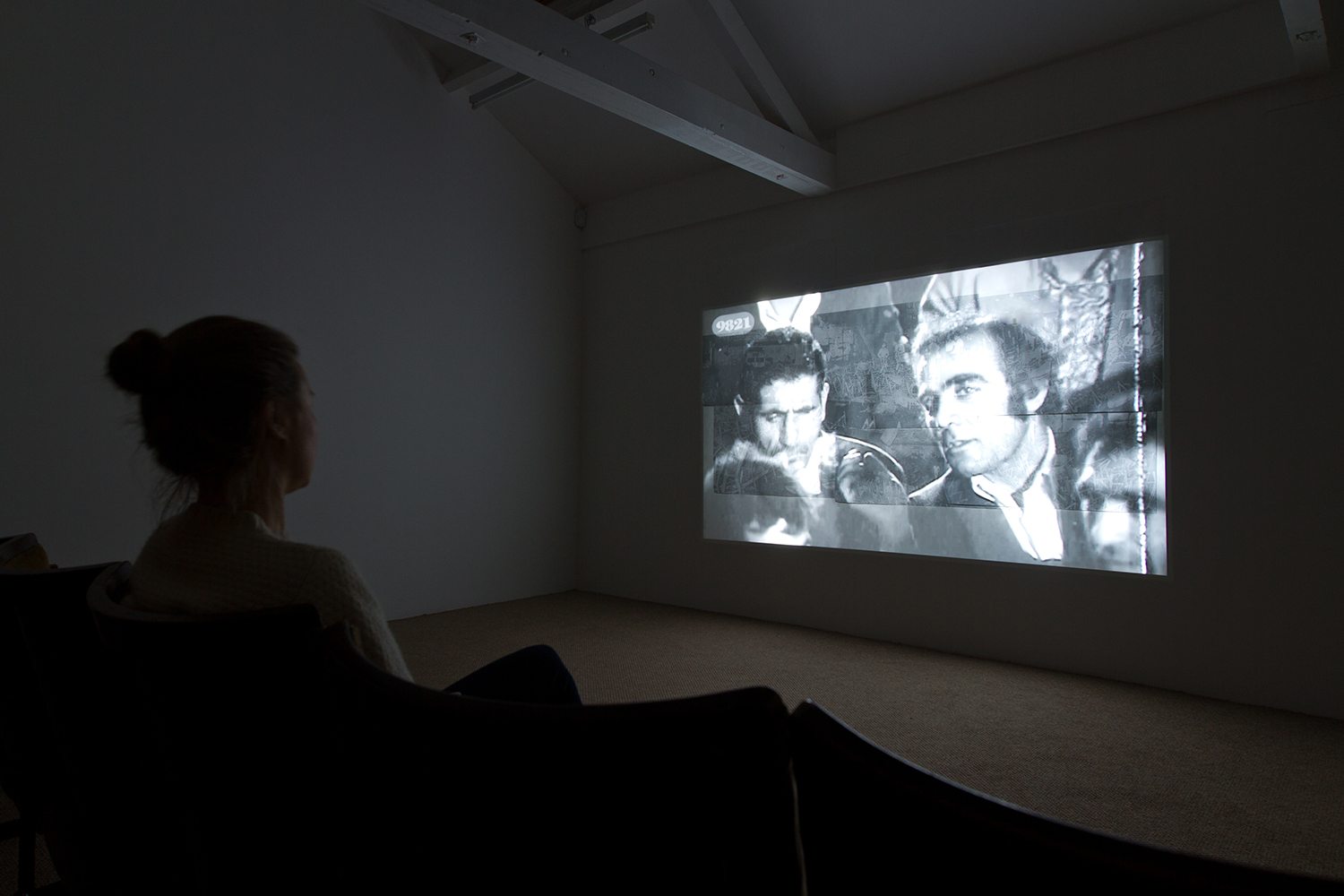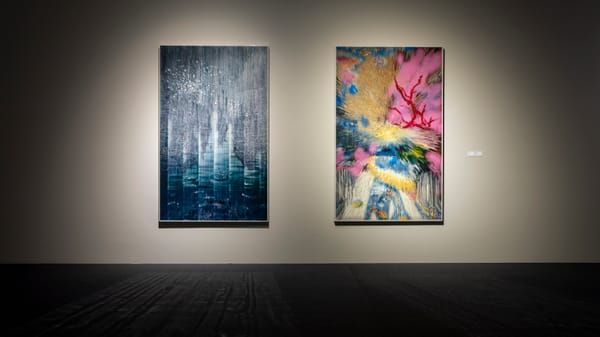Shows
Mahmoud Bakhshi’s “The Unity of Time and Place”


Mahmoud Bakhshi’s exhibition “The Unity of Time and Place” is an installation that takes up the entirety of an intimate gallery space. The two rooms of London’s Narrative Projects have been set up as small cinemas with rows of vintage flip-up theater seats. The first “cinema” screens a soundless, black-and-white film showing an audience in a theater, watching a play. The quotidian scene is clearly one of proletarian entertainment, as people chat and come and go, while the lead actress breaks character to address a member of the audience during a moment of high drama in which a character is stabbed to death. The film is projected over a set of black-and-white photographs showing what appears to be a theater after the destruction of a fire. The short sequence concludes with stage curtains closing, and the actors step out of character as—finally, we hear a score—blown horns and clanged bells and cymbals from some sort of street demonstration or parade rises.
The second film sequence shows a close-up of the film director Masoud Kimiai being interviewed, though again the picture is shown without sound, focusing our attention on reading the facial expressions appearing to portray both sadness and regret. Bakhshi’s caption texts inserted into the films lead the viewer in reading a historical narrative. The theater scene is taken from Kimiai's The Deers (1974), an Iranian film depicting the tragic life of two childhood friends experiencing the darkness of the Shah's regime as they descend into criminal activities and drug addiction. The cultural significance of The Deers—Bakhshi tells us the film’s release in Iran was held up for four years due to censorship—has been overwritten by its role in overthrowing the Shah. Kimiai's film was being screened at the Cinema Rex in Abadan city on August 19, 1978, when the building was deliberately set on fire. Apparently, around 400 people died (sources place the estimate between 377 and at over 500), and the Shah’s regime received immediate blame. That sparked protests that fueled an existing anti-monarchy revolutionary movement. The text inserted by Bakhshi into the film tells us the scene from The Deers that we are watching was being shown in Cinema Rex precisely when the fire broke out.


The effect of Bakhshi’s film installation is overwhelming; the classical unity of the theater depicted in the film, combined with the spectacle of the exhibition installation, created a situation in which the viewer, by proxy, inhabits a circumstance that was the nexus for a transforming moment in contemporary Iranian history. While the historical “facts” of the Cinema Rex fire are still open to debate, the effects of ensuing violent episodes are charted out by Bakhshi in a timeline of events that scrolls over the interview with Kimiai. The timeline makes explicit connections between the Cinema Rex fire of August 19, 1978, and the Shah’s celebration on the same day of the coup that removed Iranian prime minister Mohammad Mosaddegh in 1953. This unwinding of the historical narrative is a common thread in contemporary Iranian art, and I am reminded of Mitra Tabrizian’s photomontage Surveillance (1988–89). Bakhshi presents an exchange found in Tabrizian’s earlier work—the faces of the audience in Bakhshi’s found footage stare out at us, and the viewer is made to question their role in the scene, even as another murder victim lies on the floor. The inclusion of Kimiai, as the mute witness to decades of violence that rolled out as an indirect consequence of his work’s presentation, is a reflection both on the responsibility of the artist and the limits of artistic expression in conveying these atrocities.
Bakhshi’s text reports that the identities of those responsible for the fire, and even the actual number of victims, remain contested. The Unity of Time and Place leaves viewers with a feeling of unease. There is no cathartic release as the dramatic overdrive of Kimiai's film found within Bakhshi’s artwork is left unresolved, while the director’s decision to remain mute about his own film—and the fire—leaves us with unanswered questions. Bakhshi tells us that, after agreeing to be interviewed, Kimiai asked for his words to be removed in an act of self-redaction. As an added twist, I was told by the staff at Narrative Projects that Bakhshi’s visa application to enter the United Kingdom was rejected, so the artist was unable to be present for his own show—a renewed representation of the limits placed on artists who wish to speak out in the 21st century.

Mahmoud Bakhshi’s “The Unity of Time and Place” is on view at Narrative Projects, London, until March 11, 2017.







